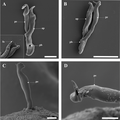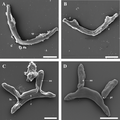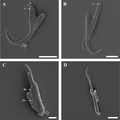
Cichlidogyrus is a genus of monopisthocotylean monogeneans in the family Ancyrocephalidae. The type-species of the genus is Cichlidogyrus arthracanthusPaperna, 1960, by original designation. All the species of the genus are parasites on the gills of fish, namely African Cichlidae, Nandidae and Cyprinodontidae.

The Diplectanidae are a family of monopisthocotylean monogeneans. They are all parasitic on the gills of fish. Diplectanids are small animals, generally around 1 mm in length. As parasites, they can be extremely numerous, up to several thousand on an individual fish.

Pseudorhabdosynochus epinepheli is a diplectanid monogenean parasitic on the gills of species of groupers. It is the type species of the genus Pseudorhabdosynochus Yamaguti, 1958.

Pseudorhabdosynochus regius is a diplectanid monogenean parasitic on the gills of the mottled grouper .
Calydiscoides is a genus of monopisthocotylean monogeneans, included in the family Diplectanidae.

Pseudorhabdosynochus americanus is a diplectanid monogenean parasitic on the gills of groupers. It was described as Diplectanum americanum by Price in 1937 and transferred to the genus Pseudorhabdosynochus by Kritsky and Beverley-Burton in 1986. The species was redescribed by Kritsky, Bakenhaster and Adams in 2015.

Pseudorhabdosynochus justinella is a diplectanid monogenean parasitic on the gills of the red grouper, Epinephelus morio. It has been described by Kritsky, Bakenhaster and Adams in 2015.

Pseudorhabdosynochus kritskyi is a diplectanid monogenean parasitic on the gills of the gag, Mycteroperca microlepis. The species has been described by Dyer, Williams and Bunkley-Williams in 1995 and redescribed successively by Yang, Gibson and Zeng in 2005 and by Kritsky, Bakenhaster and Adams in 2015. The name of the species honours the American parasitologist Delane C. Kritsky.

Pseudorhabdosynochus capurroi is a diplectanid monogenean parasitic on the gills of the Black grouper, Mycteroperca bonaci. It was described by Vidal-Martínez and Mendoza-Franco in 1998 and redescribed successively by Yang, Gibson and Zeng in 2005 and by Kritsky, Bakenhaster and Adams in 2015.
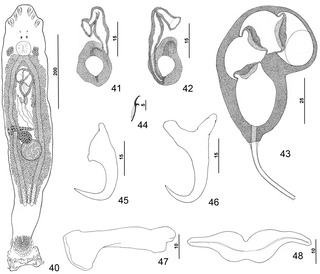
Pseudorhabdosynochus hyphessometochus is a diplectanid monogenean parasitic on the gills of the yellowmouth grouper, Mycteroperca interstitialis. It has been described by Kritsky, Bakenhaster and Adams in 2015.

Pseudorhabdosynochus firmicoleatus is a diplectanid monogenean parasite on the gills of the Yellowedge grouper, Epinephelus flavolimbatus and the Snowy grouper, Epinephelus niveatus. It was described by Kritsky, Bakenhaster and Adams in 2015.
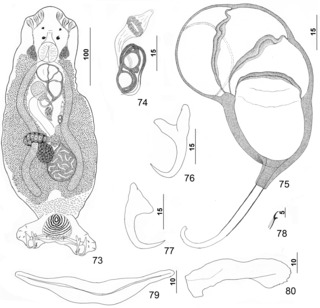
Pseudorhabdosynochus mcmichaeli is a diplectanid monogenean parasitic on the gills of the scamp, Mycteroperca phenax. It has been described by Kritsky, Bakenhaster and Adams in 2015.

Pseudorhabdosynochus williamsi is a diplectanid monogenean parasitic on the gills of the rock hind, Epinephelus adscensionis. It has been described by Kritsky, Bakenhaster and Adams in 2015.

Pseudorhabdosynochus bunkleywilliamsae is a diplectanid monogenean parasitic on the gills of the Nassau grouper, Epinephelus striatus. It has been described by Kritsky, Bakenhaster and Adams in 2015.
Cichlidogyrus vandekerkhovei is a species of monopisthocotylean monogeneans in the family Ancyrocephalidae. It was first found infecting the gills of Ophthalmotilapia ventralis in Lake Tanganyika. It can be differentiated from its cogenerates by the unusual length of its dorsal transverse bar auricles.
Cichlidogyrus makasai is a species of monopisthocotylean monogenean in the family Ancyrocephalidae. It was first found infecting the gills of Ophthalmotilapia ventralis in Lake Tanganyika. It can be differentiated from its cogenerates by the unusual length of its dorsal transverse bar auricles.
Cichlidogyrus centesimus is a species of monopisthocotylean monogenean in the family Ancyrocephalidae. It was first found infecting the gills of Ophthalmotilapia ventralis in Lake Tanganyika. It can be differentiated from its cogenerates by possessing a spirally coiled thickening at the end of its penis, the accessory piece in the genital apparatus being nonexistent, and a particular uncinuli configuration in its haptor. Its specific epithet is derived from the Latin centesimus, meaning "hundredth", due to the fact that it was the 100th species described by Antoine Pariselle.

Pseudocrenilabrus philander or the southern mouth-brooder is a small species of haplochromine cichlid found in southern and central Africa. It was first described by the German-Dutch zoologist Max Carl Wilhelm Weber in 1897.
Laminiscus is a genus of monogeneans in the family Gyrodactylidae. It consists of one species, Laminiscus gussevi . Laminiscus is a marine parasite, using its haptor to attach itself to a marine fish host. Its haptor consists of no dorsal bar, additional internal support plates, hamuli with distinct dorsal and ventral roots, and marginal hook sickles with poorly developed heels and short handles.

Enterogyrus is a genus of monogeneans belonging to the family Ancyrocephalidae.

